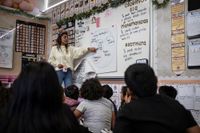Explore web search results related to this domain.
The Emergent Bilingual Support Division provides direction and leadership with the implementation of Bilingual and English as a Second Language (ESL) Programs for emergent bilingual (EB) students/English learners (ELs).
The TEA Emergent Bilingual Support Division has developed program implementation Texas Effective Dual Language Immersion Framework (TXEDLIF), TBE, ESL rubrics and associated tools to support LEAs with evaluating and enhancing their bilingual and English as a Second Language (ESL) programs.These resources, tools, and web pages provide guidance on bilingual and English as a second language (ESL) program requirements:The following statutes relate to bilingual and English as a second language (ESL) programs:The TEA Emergent Bilingual Support Division welcomes Local Education Agencies (LEAs) and regional Education Service Centers (ESCs) to join our Emergent Bilingual Support Division Meetings.
Language exchange is a method of language learning based on mutual language practicing by learning partners who are speakers of different languages. This is usually done by two native speakers teaching each other their native language. Language exchange is different from other Language learning ...
Language exchange is a method of language learning based on mutual language practicing by learning partners who are speakers of different languages. This is usually done by two native speakers teaching each other their native language. Language exchange is different from other Language learning methods as there is usually no set syllabus or activities.In modern contexts, "language exchange" most often refers to the mutual teaching of partners' first languages. Language exchanges are generally considered helpful for developing language proficiency, especially in speaking fluency and listening comprehension.Language exchanges that take place through writing or text chats also improve reading comprehension and writing ability. The aim of language exchange is to develop and increase language knowledge and intercultural skills. This is usually done through social interaction with the native speaker.This practice has long been used by individuals to exchange knowledge of foreign languages. For example, John Milton gave Roger Williams an opportunity to practise Hebrew, Greek, Latin, and French, while receiving lessons in Dutch in exchange. Language exchange first came about in the early 1800s where school aged children in England were introduced to the newly set up program.Countries such as Belgium and Switzerland found the language exchange program very easy to run as there were many languages spoken in the one country. French and German youth picked up language exchange in 1968 which then spread to Turkey and Madrid. Universities are increasingly experimenting with language exchanges as part of the language learning curriculum.

The translations read “nekône taꝏmâôk,” for First Street, with the following ordinal numbers as “neese,” “neeshwe,” “yâwe,” and more.
Following through on a project submitted through our Participatory Budgeting initiative, Cambridge officials and members of the local Massachusett tribe today unveiled new street signs that are now available in the English and Massachusett language from First to Eighth streets.

I wanted to raise my kids to be bilingual because I am the last guardian of my family’s tongue, straddling the old world and the new.
Was it because their father wasn’t fluent in my language, even though he’d promised to learn it when we were dating? (To be fair, I promised to learn to make Tater Tot casserole and that hasn’t happened either.) ... A grandmother’s handwritten instructions for borscht, dumplings and stuffed chicken necks are recipes for resilience. June 26, 2022 · I felt lost and alone in my guilt. I wanted to raise my kids to be bilingual not for its cognitive perks — of which there are plenty — but because as an immigrant, I am the last guardian of my family’s tongue, straddling the old world and the new.Without the language and the history it holds, however complicated, I feared my children would never understand a vital part of my identity and theirs, never forge connections with relatives near and far. I started reading, having honest conversations with other immigrant parents and, most of all, observing. I found that there is no one-size-fits-all magic formula for raising bilingual kids.And the results will likely not be perfect. Kids (and adults) are capable of becoming bilingual at any age, but because bilinguals don’t use their languages in the same way and to the same degree, those who achieve truly equal fluency are like unicorns: They areThe latter is called the “one parent, one language” method, or OPOL, and this approach has many adherents. But it isn’t realistic for my family. ... Encourage your bilingual baby to use multiple languages by talking, reading and singing with them. Human interaction will foster their bilingual learning.

How do you help children become fluent in two or more languages, even if you don't speak other languages yourself?
After this, children lose the ability to tell apart sounds that are not used in their native language or languages they are exposed to. ... Choosing a bilingual babysitter or participating in exchange programmes can help advance language learning (Credit: BBC/Getty Images)Marian suggests a range of options, for example, choosing a bilingual babysitter or nursery or signing their children up for language lessons at a community centre or after-school club where they hear multiple languages. "As the child grows older, having them participate in exchange programmes and study abroad programmes, take foreign language courses, and travel to countries where the other language is spoken will further support and advance language learning," she says.My parents raised my sisters and I bilingually from birth. They sought advice and were told to only speak their respective languages to us. They stuck to this so strictly that for an embarrassingly long time we did not realise that they both spoke Dutch and English fluently.Nowadays, we speak a Dutch-English blend at home, often switching between languages mid-sentence. However, there is still a common idea that the model my parents followed is the best guarantee of raising truly bilingual children: start at birth, with each parent strictly sticking to their native language.
If local groups are not available, several platforms exist (some may have premium paid options) such as Tandem or Tandem Partners; Italki, Open Language Exchange or Speaky are great for finding a mother tongue partner or a teacher, while Coeffee also allows you to play language games with other ...
An easy way to look for a local tandem mate is by using Facebook groups, you can type some keywords, for example: “Tandem” or “Language Exchange” and the name of the city you are living in, to find out about local initiatives usually hosted in a pub or in a cafe.If local groups are not available, several platforms exist (some may have premium paid options) such as Tandem or Tandem Partners; Italki, Open Language Exchange or Speaky are great for finding a mother tongue partner or a teacher, while Coeffee also allows you to play language games with other students.This tool is available in the 24 official EU languages. It’s free, however, you have to be enrolled in an EU youth project to access it. Participating in a study period abroad, a youth exchange or a volunteering experience abroad is also a great way to develop your linguistic skills.Finding a tandem partner can be done through various methods like language exchange apps, online communities, or even local meetups for language learners.

ESL Conversation Lesson Questions: Free classroom handouts. English lesson on LANGUAGE. Use for debates, discussions, speaking, conversations, independent learning and more.
ESL Discussions: Free worksheet and online activity on Language.


If you want to master a language, use it! Drop the old excuse that you have no-one to practise your Dutch or Portuguese with. Join a conversation exchange and you can improve your skills for free.
An easy way to look for a local tandem mate is by using Facebook groups, you can type some keywords, for example: “Tandem” or “Language Exchange” and the name of the city you are living in, to find out about local initiatives usually hosted in a pub or in a cafe.If local groups are not available, several platforms exist (some may have premium paid options) such as Tandem or Tandem Partners; Italki, Open Language Exchange or Speaky are great for finding a mother tongue partner or a teacher, while Coeffee also allows you to play language games with other students.This tool is available in the 24 official EU languages. It’s free, however, you have to be enrolled in an EU youth project to access it. Participating in a study period abroad, a youth exchange or a volunteering experience abroad is also a great way to develop your linguistic skills.Finding a tandem partner can be done through various methods like language exchange apps, online communities, or even local meetups for language learners.

After banning bilingual education in 1998, California voters brought it back 8 years ago. Schools are still trying to rebuild their programs.
Students discuss American heroes in their Spanish language class at Washington Elementary School in Madera on Oct. 29, 2024. The whole school is dual language. Photo by Larry Valenzuela, CalMatters/CatchLight Local ... The nation’s most linguistically diverse state has a tortured history with bilingual education in public schools.By 1998, the bilingual-teacher prep program was flourishing. Flores helped aspiring teachers understand how students learn to read and write in two languages, sending them off into classrooms with binders full of instructional tips. Her daughter, then 10, was learning both English and Spanish through bilingual classes in the San Bernardino City Unified School District.Faculty on campus called for the elimination of her program, an effort that ultimately failed but showed, she said, “the intensity of the discrimination and language racism that was prevalent.” Enrollment in bilingual-teacher prep programs across the state plummeted.And over the next two decades, researchers studying programs across the United States released a steady stream of evidence about the benefits of bilingual education, especially a version called “dual language.” Traditional bilingual education essentially lets students use their first language while they learn English.

This ESL lesson plan is designed around a short video titled Why being bilingual is good for your brain and the theme of being bilingual. Students learn vocabulary related to bilingualism, talk about bilingualism, predict the content of a short video, watch a short video, answer comprehension ...
This ESL lesson plan is designed around a short video titled Why being bilingual is good for your brain and the theme of being bilingual. Students learn vocabulary related to bilingualism, talk about bilingualism, predict the content of a short video, watch a short video, answer comprehension questions, analyse a short video, write about what […]This ESL lesson plan is designed around a short video titled Why being bilingual is good for your brain and the theme of being bilingual. Students learn vocabulary related to bilingualism, talk about bilingualism, predict the content of a short video, watch a short video, answer comprehension questions, analyse a short video, write about what they have learned from a short video, and reflect on the lesson. Language level: Intermediate (B1) – Upper Intermediate (B2)We hope you enjoy this ESL lesson.

Learn about bilingual education in the classroom including transitional, dual immersion, and late-exit/developmental bilingual education.
Educators usually teach students in their native language in conjunction with a second language utilizing differing levels of the native and second language depending on the requirements specified in lesson plans and teaching models. Below are common bilingual education models employed in public school schools, charter schools and private institutions across the United States.Transitional Bilingual Education. This type of bilingual education is designed to help students learning a new language pick it quicker and make the transition to begin learning math, science, and other subjects in English.Non-English and English speaking students learn together in dual immersion bilingual education programs. Another type of dual language program teaches students using the following steps: 1) Teachers instruct students in a second language but are able to understand students when they must ask questions in their native languages.They will continue to be taught these subjects in a second language. This way, students will only receive grammar and language instruction in their native language, so it can be later applied to their foreign language instruction. Late-Exit or Developmental Bilingual Education.

What the California Legislature and education department have — and have not — done to ensure access to bilingual education.
About a decade later, the state started to require bilingual education for kids who couldn’t understand English, taking up a Civil Rights-era argument that the children of immigrants deserved an education in their native language to be able to get the full benefits of public schooling.Unlike in the 1970s, the California Legislature has not stepped up to require bilingual education or fund a systemic recovery from the English-only years. Since Massachusetts ended an English-only law of its own, the state has awarded $11.8 million to help schools start or expand dual-language programs.Bilingual education lets kids use their native language while they learn English. Kids who already know how to read and write in one language just have to transfer those skills to a second language rather than learning the processes from scratch.Dual-language programs set all students up for the “bilingual advantage.” Traditional bilingual education creates a pathway to English-only classes as quickly as possible. Succeeding in English-language classes is the goal.

13 Government Programs for Teaching English in Spain: A Complete Guide for Aspiring ESL Teachers. Teach English Abroad.
It’s ideal for those who want to teach in larger cities like Tefl Madrid or Tefl Barcelona, and it comes with the added benefit of being part of a bilingual curriculum, which can boost your resume for future teaching opportunities. The EFL Teacher Exchange Program allows you to teach English in Spain while also providing opportunities to exchange experiences with other teachers from around the world.Erasmus+ provides funding for teachers to gain international experience, develop professionally, and improve language skills. This is a fantastic option for those looking for a flexible, short-term commitment while still being compensated for living expenses. It’s especially great if you’re interested in working in Tefl Seville or Tefl Barcelona. This program is designed to assist schools that offer bilingual education programs in Spain.The role typically involves helping students with their English language development and teaching subjects like English, history, or geography in English. Location: Available across the country, with significant opportunities in Madrid, Barcelona, Seville, and Marbella ... The Bilingual Assistant Program offers teachers a great way to work in more prestigious bilingual schools.If you enjoy cultural exchange and want to work alongside educators from various backgrounds, this program is for you. It’s perfect for those seeking a community-driven teaching role and those who want to gain insight into the local culture and language of Tefl Seville or Tefl Marbella.
Live a unique experience abroad with ESL! Choose between 20 languages & 200 destinations for your language course abroad. ESL helps you with everything, free of charge.
The importance of ESL is reflected in the fact that many districts even require all elementary teachers to have an ESL certification. You’ll want to make sure to research your top choice school to determine if you need ESL. Bilingual Education teachers instruct in two different languages.
The importance of ESL is reflected in the fact that many districts even require all elementary teachers to have an ESL certification. You’ll want to make sure to research your top choice school to determine if you need ESL. Bilingual Education teachers instruct in two different languages.The goal of bilingual classroom instruction is to help students become fluent in both languages. Like ESL classrooms, students may also come from different cultural backgrounds.Both ESL and Bilingual Education teachers are in high demand. In a rapidly diversifying world, the use of English is on the rise. Since 1965, the number of immigrants in the U.S. has quadrupled; this means many students are entering our school systems without the simple tools needed to succeed, such as understanding the language of instruction – English.One out of every four students speak a language other than English in their home and our school systems are struggling to provide every student with teachers they need. Every student is equally important, and ESL and Bilingual teachers truly go above and beyond to meet the needs of all our students.

Language exchange app for foreign language conversation practice. Chat, play and learn with native speakers. Find the best conversation exchange partners!
With Bilingua’s matching algorithm, you get to connect with the best language partners suited for you.Be on top of language learning. On Bilingua, you get access to topic recommendations, learning tips and 1-on-1 tutors — soon!So great app!!! I've downloaded thid app only few mins ago but I already can tell that's the best language exchange app I've ever tried~ Super design, very kind peopleThere are millions of people like me out there who are desperate to improve English language proficiency in speaking.


The state prohibited bilingual education off and on until 2016. Without enough teachers or money, schools haven’t recovered.
Students, some of whom speak languages other than Spanish or English at home, at Washington Elementary School in Madera on Oct. 29, 2024. Photo by Larry Valenzuela, CalMatters/CatchLight Local · It has been eight years since California voters repealed a 1998 law directing public school districts to essentially eliminate their bilingual programs.But the fallout from the state’s vacillating history of bilingual education has led to California falling short of providing a quality education not only to non-English speakers but also to students who want to be bilingual. · As CalMatters higher education reporter Tara García Mathewson explains, in 1998 California voters approved a law requiring schools to teach classes only in English with students who were not fluent with the language, with few exceptions.There are many benefits for schools to have bilingual education: It allows students who are not proficient in English to still be able to learn school subjects in their native language while they also learn English. Schools with strong dual-language programs, a type of bilingual instruction approach, also report better student outcomes, including higher test scores and graduation rates.Gavin Newsom signed a law this year requiring the education department to develop a plan for districts to adopt the state’s English Learner Roadmap. The Legislature also allocated in 2017 roughly $20 million to help districts prepare bilingual staffers to lead bilingual classrooms, and budgeted another $10 million in 2021 to start or expand dual-language programs.
The Mixxer hosted by Dickinson College is an entirely free non-profit website hosted by Dickinson College. What began as a small project to help Professor Meguro at Dickinson College find Japanese partners for her students has expanded to 30 - 40,000 active users per month around the world.
They are obliged to have a conversation with native speakers of French, starting with our NOVA ESL students from Francophone countries, family members who speak French fluently and students who use the Mixxer, a well-established language exchange program organized by Todd Bryant at Dickinson College."When a university language course costs up to $5,500 a semester, it’s no wonder so many American adults never become bilingual in their spare time."Becoming bilingual opens up a whole new world of different people, different cultures, and different emotions. It also takes a huge time commitment—one that many of us can't dedicate to.
The choice should be made at the ... and the resources available. ESL programs (rather than bilingual programs) are likely to be used in districts where the language minority population is very diverse and represents many different languages....
The effectiveness of various program models for language minority students remains the subject of controversy. Although there may be reasons to claim the superiority of one program model over another in certain situations (Collier 1992; Ramirez, Yuen, and Ramey 1991), a variety of programs can be effective. The choice should be made at the local level after careful consideration of the needs of the students involved and the resources available. ESL programs (rather than bilingual programs) are likely to be used in districts where the language minority population is very diverse and represents many different languages.This is a variation of the pull-out design, bringing students together from several classrooms or schools. The resource center concentrates ESL materials and staff in one location and is usually staffed by at least one full-time ESL teacher. All bilingual program models use the students' home language, in addition to English, for instruction.Students serve as native-speaker role models for their peers. Two-way bilingual classes may be taught by a single teacher who is proficient in both languages or by two teachers, one of whom is bilingual. Some programs provide neither instruction in the native language nor direct instruction in ESL.These use only English, but there is no explicit ESL instruction. As in sheltered English and content-based programs, English is taught through the content areas. Structured immersion teachers have strong receptive skills in their students' first language and have a bilingual education or ESL teaching credential.

Bilingual education teachers teach in two languages, while ESL teachers focus solely on English. A master’s degree in bilingual/ESL education prepares teachers for either profession.
Bilingual education teachers are fluent in students’ native language and able to ease the transition between students’ native language and English. ESL teachers, on the other hand, do not speak the student’s native language, instead focusing on implementing the best process for immersing students in the English language.Both ESL and bilingual education are effective for teaching students English, but which approach will you utilize in your classroom? ESL classrooms are filled with students with diverse backgrounds, cultures, and languages. However, there’s only one language used for teaching in an ESL classroom: English.Do ESL teachers have to be bilingual? No, English is the only language an educator needs to know to excel as an ESL teacher. The principle driving ESL education is that students will learn English faster if they are immersed in the language. Although they’re supported every step of the way, it’s sink or swim for ESL learners as they’re taught to read, write, and speak English.Furthermore, students’ proficiency in their native language may suffer as they focus solely on learning English. As an ESL teacher, it would be your job to help your class overcome these challenges. If you are fluent in a second language, bilingual education may be the more fulfilling and financially rewarding career option.






